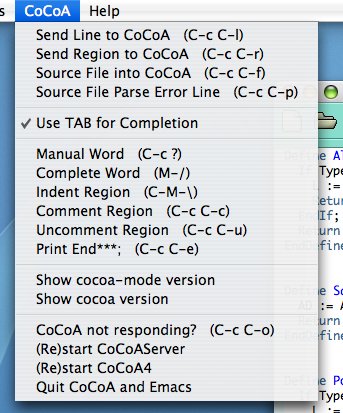Difference between revisions of "CoCoA:Emacs interface"
From ApCoCoAWiki
(added CoCoA menu picture) |
|||
| Line 9: | Line 9: | ||
* automatic loading of <code>wordlist.txt</code> for dynamic abbrev expansion (<code>M-/</code> or <code>ESC /</code> or <code>TAB /</code>) | * automatic loading of <code>wordlist.txt</code> for dynamic abbrev expansion (<code>M-/</code> or <code>ESC /</code> or <code>TAB /</code>) | ||
| − | === CoCoA menu === | + | === CoCoA menu === |
| − | [[Image:CoCoAMenu]] | + | [[Image:CoCoAMenu.jpg|right|CoCoA menu for cocoa-mode]] |
From the menu you can | From the menu you can | ||
* send lines, regions and files to cocoa | * send lines, regions and files to cocoa | ||
Revision as of 10:20, 19 October 2005
cocoa-mode
The distribution of cocoa-4.5 includes an emacs/ directory which contains cocoa.el and cocoa.emacs (the settings to be added to your .emacs).
- a friendly CoCoA menu
- automatic indentation
- coloured syntax (in font-lock-mode - default)
- capitalization of keywords (in abbrev-mode - default)
- automatic loading of
wordlist.txtfor dynamic abbrev expansion (M-/orESC /orTAB /)
From the menu you can
- send lines, regions and files to cocoa
- (if you had a parse error after sending a file) go to the parse error line
- start or restart the CoCoAServer
Some key bindings in cocoa-mode
C-c C-e(like in latex-mode) writes the appropriate "End" (EndIf,...)C-c C-c(like in c-mode) comment-region
If the following features do not work you should customize the variable cocoa-executable in cocoa.emacs:
Calling CoCoA
From a buffer in cocoa-mode you can select things and "send" them to a cocoa buffer (called *cocoa*) to be evaluated:
C-c C-l(evaluate line)C-c C-r(evaluate region)C-c C-f(evaluate file)C-c C-morC-c ?(evaluate CoCoA manual for the word under the cursor)
They will automatically start CoCoA (if it isn't already running in a *cocoa* buffer).
M-x cocoaopens a buffer (called*cocoa*) with a running CoCoA
